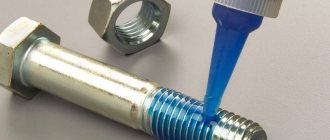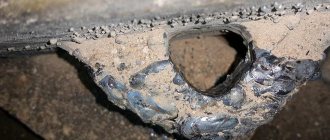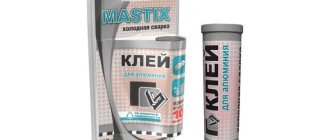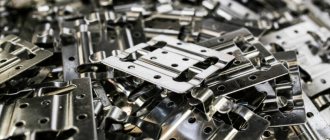When cast iron is heated, the carbon burns out and the metal becomes brittle and breaks. It is better to connect parts and correct defects by cold welding cast iron. The high-carbon alloy does not overheat, the graphite between the crystals is preserved. Cold joints are made using copper electrodes and are suitable for seams with light loads.
Cold welding refers to processes that are completely different in technology: connections with copper electrodes and sealing of defects with a special adhesive composition. Each method has its advantages and disadvantages.
Cold welding of cast iron (Photo: Instagram / budmetpro)
Difficulties
Cast iron alloys have a high carbon content. Some of the graphite is in crystals, the rest is located between the grains. When it burns out, the bonds are broken and the metal can crumble upon impact. This property of cast iron creates an obstacle to traditional methods of joining workpieces.
The second obstacle is the low thermal conductivity of the metal, which leads to the formation of cracks along the heating boundary. Having gained heat, the material slowly cools down and remains hot for a long time. Special cast iron electrodes of the OZCh and MNC brands are used. This raises difficulties:
- various oxides in cast iron oxidize at a temperature lower than the cast iron itself, resulting in lack of penetration;
- hard and brittle cementite is formed in the heat-affected zone;
- the melting temperature of the electrode is higher than that of the base metal, the joining of materials is poor;
- cast iron is characterized by high fluidity and is difficult to keep in the weld pool;
- During welding, carbon burns, gases form pores and air pockets in the seam.
Before joining using a graphite and cast iron electrode, high-carbon materials are traditionally heated using stepwise temperature raising technology and holding until completely heated. There are 2 welding processes:
- high temperature - hot, with heating 600 - 650⁰;
- semi-hot - 350⁰.
For large parts, the oven curing process lasts 20–24 hours. After welding the defects and connecting the workpieces, a long tempering is done. The process takes a long time, more than 2 days.
Security measures
Cold welding is a fairly safe joining method, unlike classical welding, where metal melts under high temperatures. However, there are still dangers in use.
Mixing cold welding, both liquid and dry, and the application process must be performed with gloves (preferably rubber). This will protect the skin of your hands from burns from the components of the composition.
When applying liquid compositions, you need to be very careful so that the composition does not get into your eyes. In case of contact, rinse with plenty of water and immediately consult a doctor (ophthalmological emergency room).
When using a liquid composition for plastic and linoleum, care should be taken to ventilate the room since the composition uses solvents.
You should also be very careful to ensure that cold welding does not reach children. Dry compounds are similar to plasticine and they are often interested in them.
Types of welding
The term “cold” means that the parts are not heated in the furnace before electrode welding and cast iron is welded using a special technology that has its own characteristics. The seam lies on cold metal.
There are two methods of cold welding in practice:
- special copper electrodes;
- polymer adhesives.
Both methods have one drawback. They can be used to create low-load seams. Strong connections that can withstand vibrations, shocks, and bends are made only using the hot method.
Welding with electrodes (Photo: Instagram / mdfkl.belarus)
Electrodes
For cold welding, electrodes with a copper rod are used. Ductile metal easily forms a connection with cast iron. The seam is softer than the parts being connected themselves; it can withstand static bending loads.
In production, when welding parts more than 20 mm thick, combined electrodes made of steel and copper are used. They have different options:
- cover the copper rod with steel foil;
- a non-ferrous metal tube filled with steel powder.
Welding of wide seams and surfacing is carried out with a bunch of electrodes. For cold welding, bundles of steel and copper electrodes with coating are used.
All cold welding electrodes use copper. The non-ferrous metal penetrates between the cast iron crystals and creates a strong connection with it without the stresses of the transition zone. The condition for creating a dense seam material is forging. Immediately after moving the electrode to the side, the hot alloy should be compacted by hammering it. Any gases trapped inside will be released. The layers of metal will settle tightly, forming a homogeneous alloy.
The technological process is complex. Requires strict adherence to all points, from preparation to forging.
Polymer compositions
Cold welding is a heat-resistant polymer paste based on epoxy resin. It contains cast iron powder and is mainly used for sealing sinks. Prepare a two-component composition immediately before use. Densely fill the void in the metal or the cut seam with glue.
Polymer welding agents differ in permissible heating temperature and hardness after hardening. After mechanical processing of the part, the glue has a lighter tone. The transition is blurry, there is no clear boundary.
Cold welding is used to repair small defects in cast iron car parts. In mechanical engineering, it is used to correct casting defects in large castings, restore guide frames, and racks.
Application of the polymer composition (Photo: Instagram / vyhlop)
Instructions for use
There are a very large number of manufacturers and brands of cold welding, and therefore the methods of application vary. But for the most part, the application technology is the same. Let's consider it in more detail for each type.
Dry (solid form)
To use dry cold welding, you first need to thoroughly clean the surfaces to be joined from any types of contaminants (rust, oxide film, paint, etc.), and then you need to degrease the surfaces with acetone, a special degreaser, or a water-alcohol solution.
Afterwards, the surface must be dried, but it is better not to wipe the grease-free surface with rags, but rather let it dry. Because a rag can bring additional dirt to the surface.
Now you need to prepare the composition for use. To do this, measure out the required amount of the composition, cut it off, and then knead it in your hands.
Most manufacturers recommend performing this process with gloves so that the composition does not get on the skin of your hands. Depending on the amount of composition used, it is necessary to knead for 1 to 5 minutes until the composition becomes plastic and homogeneous.
Afterwards, you can apply the composition to the surfaces to be joined and fix them. Allow the necessary time for hardening.
During the drying process, the surface should not be loaded in any way. You also need to monitor the ambient temperature; it should not be below minus 5 degrees and above 30 - 35.
Liquid
Surface preparation for liquid cold welding is, in principle, no different from that used for dry welding. Surfaces are cleaned and degreased. If liquid welding is used for plastic, then in this case it is necessary to remove the top layer from the surface of the polymer. This can be done using a knife or cutter. This action will significantly increase adhesion, and therefore the connection will be much stronger.
If the composition is one-component, it is simply applied in a thin layer to the surface, after which the edges are fixed.
Just like with dry welding, it is necessary to maintain the drying time and not load the product being welded.
In cases where a two-component composition is used, it is mixed in the proportions specified by the manufacturer. After mixing, the composition is applied to one or both surfaces to be joined.
Manufacturers
Most types of electrodes for cold welding of cast iron are produced in the Russian Federation:
- MNC-2;
- OZZHN-1;
- OZCh-6;
- TsCh-4.
They are used in car repairs, welding of heating radiators, and at large foundries and machine-building enterprises. Popular manufacturers:
- Frunze electrode;
- Aspik;
- Special Electrode.
Of the foreign companies, consumables for welding cold cast iron are produced by German companies:
- CAPILLA;
- UTR SchweiBmaterial.
Other companies limit themselves to the production of electrodes and wire for hot welding of cast iron.
Compound
The composition of cold welding is most often based on epoxy resins, as well as additional additives that give the joint certain properties. Some compositions add reinforcing substances in the form of metallic inclusions (metal powder, polymer fibers, etc.) which increase the strength of the joint. If we are talking about hard cold welding, stabilizing (thickening) components are added to the composition.
For compositions that operate at high temperatures, heat-resistant filler components are added to prevent the destruction of the “welded” area.
Preparation for welding
Seams up to 10 mm thick should be cut in a V-shape, laid out on a work plate and tacked after 100–150 mm.
When connecting thick parts, pins are inserted into the cutting area. Their size and quantity are determined by the width of the groove and the type of connection. Holes are drilled for the studs and threads are cut into them.
If there are defects in the workpieces, such as cast iron castings, shells, cracks, they are first corrected by additional annealing and welding or pouring. Then the edges are cut for welding.
Preparing tools (Photo: Instagram / dvizhok_125)
How to use it correctly?
The brand of electrodes is selected according to the operating conditions of the part. To seal a hole in a heating radiator, it is enough to choose a low-temperature electrode that can withstand 236⁰. It connects well with cast iron due to copper, has high hardness due to the content of high-carbon steel, and can withstand impact and bending loads.
Heat-resistant electrodes that can withstand up to 1300⁰C are used to weld parts operating at high temperatures and low mechanical loads. At home, it is most convenient to cook with a rod with a diameter of 3-4 mm, constant current - 120-150 A.
Tips and tricks
Cast iron has high fluidity and is difficult to keep in the bath. Experts recommend placing the parts on the stove so that the cutting is horizontal, at the bottom.
Having made tacks, you should apply short seams up to 25 mm long and immediately hammer them with light blows of a hammer. They should be located at a distance of 150–200 mm. If the connection is short, you should wait for the workpieces to cool. You can check the readiness of the material for welding by hand. She will feel a pleasant, non-burning warmth.
Those who like to do their own repairs can use cold welding at home when repairing cars or household appliances. Small seams on small parts will not overheat the cast iron and will hold up well.
Cold welding of metals - an excursion into history
Cold welding of metals has been known since ancient times. As archaeological research and historical chronicles show, the “Colossus of Rhodes” was covered on the outside with thin copper sheets, which were connected to each other using cold welding. That is, this technology was also used to create masterpieces of the ancient period .
The National Museum in Dublin (Ireland) contains gold boxes that, according to experts, were made in the Late Bronze Age using this method.
In 1724, the priest JL Desaguliers introduced a method of joining lead using cold welding. The experiment consisted of pressing two lead balls with a diameter of about 25 mm together and rotating them, as a result they connected. Subsequent attempts to break this connection and measure the size of the break using scales showed that the strength of the connection of some samples turned out to be no worse than the base metal. The results of these experiments were published in scientific journals.
This method of obtaining a compound was first seriously looked at in the 1940s, it was at this time that scientists discovered a strange effect of the interaction of several pieces of the same metal in an absolute vacuum - in the presence of clean flat edges they attract.
Starting from the second half of the 1940s, it began to be used in industrialized countries: in 1947 - 1948. appeared in the USA, and in 1949 its use began in the USSR.
Currently, it is successfully used for joining products made of ductile metals such as copper, aluminum, lead, tin, nickel, etc.











